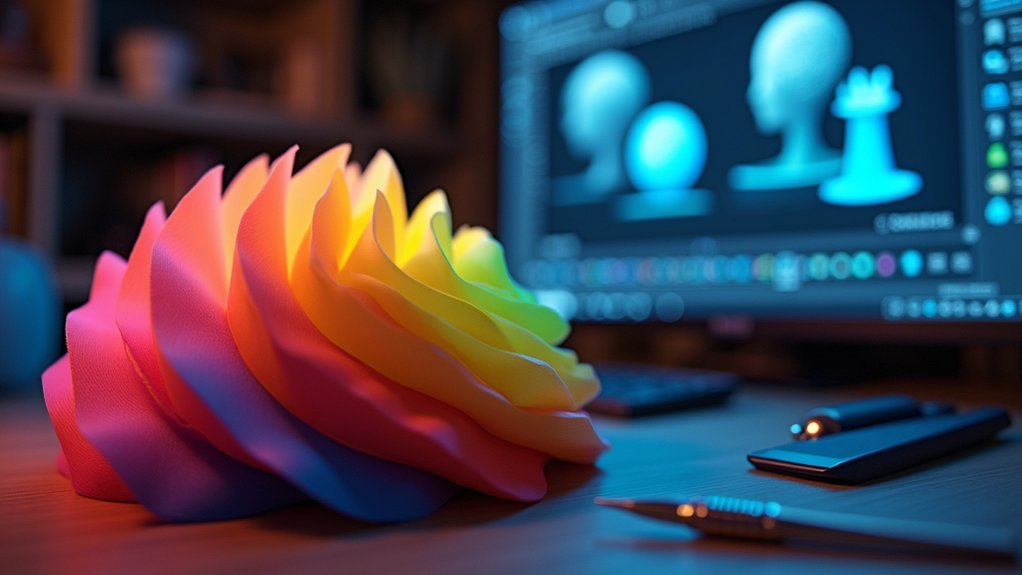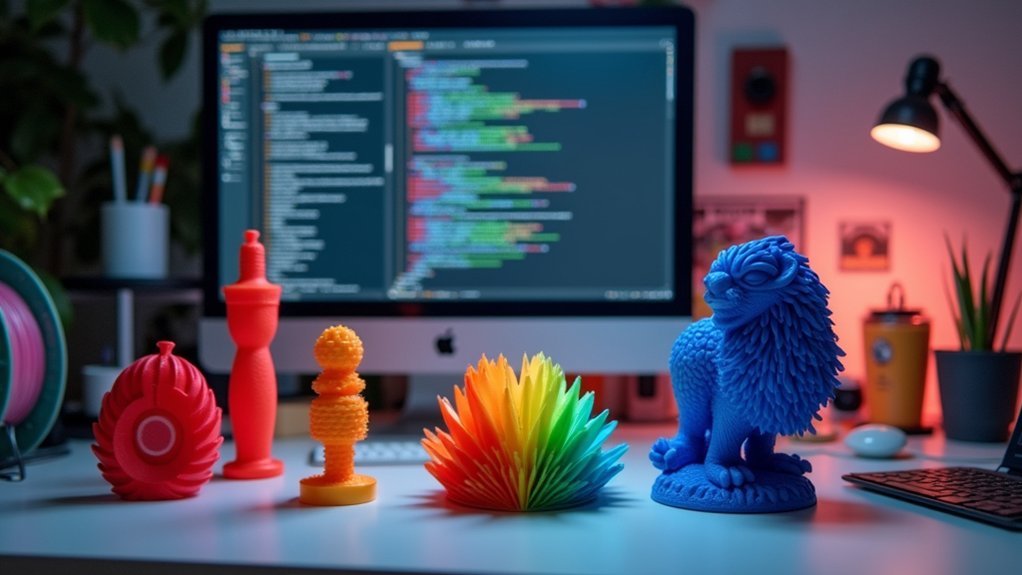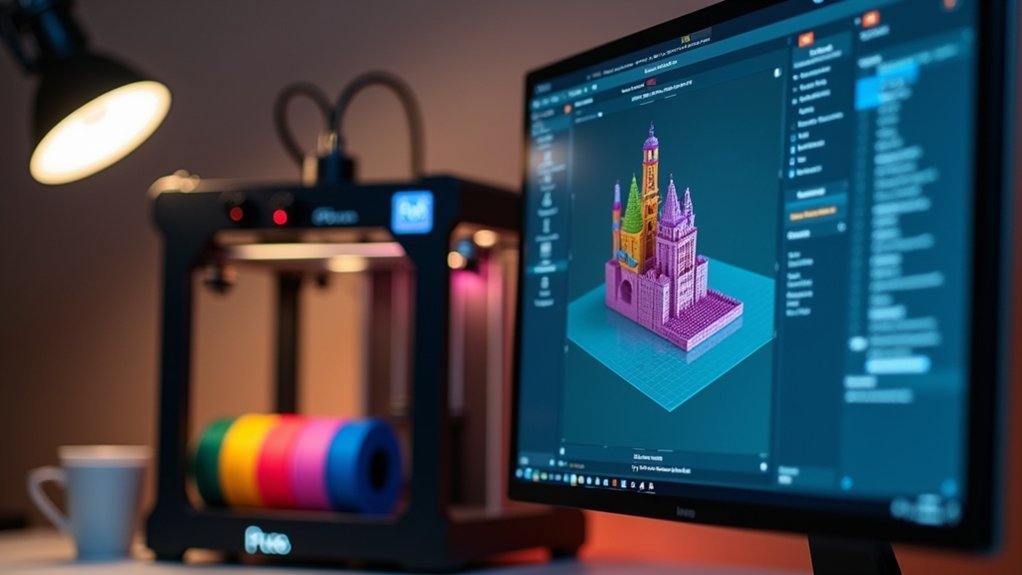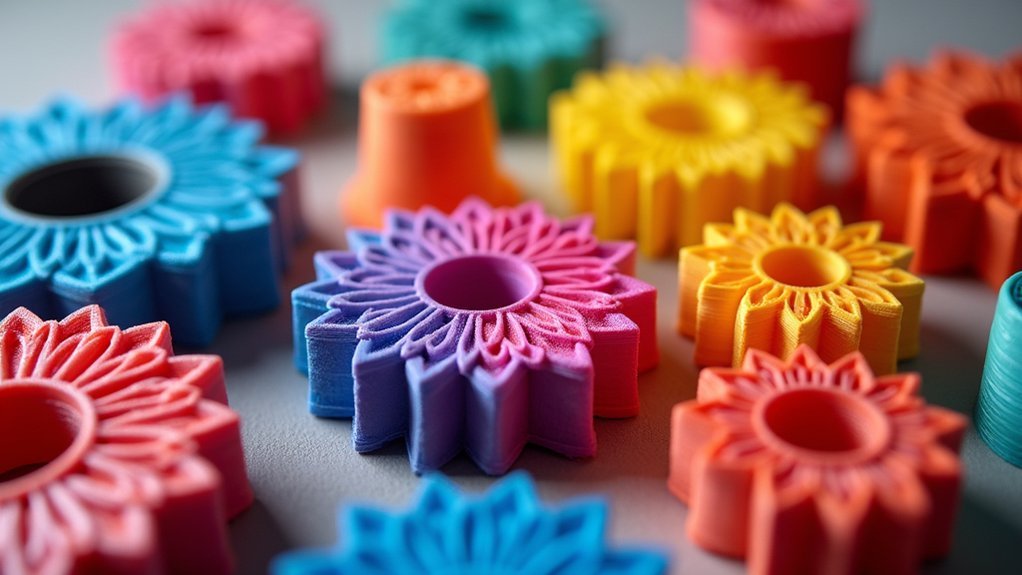You’ll want PrusaSlicer for multi-color printing because it offers precise control over extruder assignments, intelligent color sequencing that minimizes filament waste, and customizable G-code management for seamless tool changes. It’s compatible with single extruder setups using M600 commands for manual changes, multi-extruder systems, and Prusa’s MMU. The software intelligently processes color order by prioritizing previously used colors, reducing unnecessary tool changes while maintaining exceptional print quality. Discover how these advanced features transform your multi-color printing workflow.
Advanced Slicing Capabilities for Complex Multi-Color Projects

When you’re tackling complex multi color 3D printing projects, PrusaSlicer’s advanced slicing capabilities give you precise control over every aspect of the process.
You can assign different extruders to specific model parts, guaranteeing perfect color differentiation and alignment throughout your prints. The Single Extruder Multi Material option minimizes filament waste by reducing unnecessary tool changes, making your workflow more efficient.
Assign specific extruders to model parts for perfect color differentiation while minimizing waste through efficient tool change reduction.
You’ll appreciate the ability to configure custom G-code commands like M600 for seamless color shifts. The slicer’s skirt and purge object features improve filament priming while reducing ooze during color changes.
Community-driven improvements continuously enhance these capabilities, including tools like text embossing that enable more intricate multi-color designs. These advanced features guarantee your complex projects achieve professional-quality results with minimal hassle.
Single Extruder Multi-Material Configuration Options
Three key configuration steps enable PrusaSlicer’s Single Extruder Multi-Material capabilities for your multi-color prints.
First, you’ll configure multiple extruders in Printer Settings, allowing color differentiation without requiring a Multi-Material Unit. This setup lets you assign different materials to various parts of your model seamlessly.
Second, you’ll implement custom G-code for efficient tool change management. The M600 command becomes essential here, automatically pausing your printer at designated points for manual filament exchanges during the printing process.
Third, you’ll arrange parts and assign corresponding extruders within the slicer interface. This guarantees proper alignment and accurate color application throughout your multi-material project.
Additionally, disabling wipe towers minimizes filament waste, making your Single Extruder setup remarkably efficient for complex multi-color creations.
Customizable Tool Change G-Code Management

Beyond basic configuration settings, you’ll gain complete control over your multi-color printing process through PrusaSlicer’s customizable tool change G-code management system.
In Printer Settings, you can configure Custom G-code for tool changes, enabling precise control over filament exchanges. Setting your Tool Change G-code to M600 automates the filament swapping process, reducing manual intervention during prints.
You can include specific commands to manage purging and filament preparation, ensuring better shifts to the correct color. The slicer’s intelligent logic determines color order by leveraging previous layer colors, minimizing tool changes and reducing waste.
You’ll also have the option to disable the wipe tower, creating a streamlined process focused on effective tool change management.
Intelligent Color Order Processing and Optimization
Since PrusaSlicer processes layers sequentially, it leverages intelligent color selection by analyzing the last used color from the previous layer, considerably reducing unnecessary tool changes during your multi-color prints.
This Multi Material optimization prioritizes the previously completed color, streamlining filament usage and minimizing waste throughout your printing workflow.
While the current logic doesn’t look ahead to future layers, you can enhance efficiency using features like skirts with loops matching your color count.
This Material System approach effectively purges filament between changes, ensuring cleaner results when working with several colors.
Community feedback has sparked discussions about potential enhancements for even better color order processing, which could further optimize your multi-color printing workflows and reduce overall print times.
Seamless Integration With Popular 3D Printer Models

You’ll find that PrusaSlicer works exceptionally well with popular printer models like the Ender-3, offering built-in compatibility features that make multi-color printing straightforward.
The software comes with preset configuration options that automatically adjust settings to match your printer’s specifications, eliminating guesswork during setup.
Additionally, you can leverage custom G-code support to fine-tune tool changes and color shifts, ensuring your prints run smoothly regardless of your hardware configuration.
Ender-3 Compatibility Features
When you’re working with an Ender-3 printer, PrusaSlicer’s compatibility features make multi-color printing surprisingly accessible without requiring expensive hardware upgrades.
You can print in two colors using single extruder multi-material functionality, which works perfectly with your Ender-3’s existing setup. The software lets you configure tool change G-code like M600 specifically for your printer, streamlining filament swaps during printing.
You’ll have precise control over color order and layer management, helping optimize your Ender-3’s performance while reducing filament waste.
The community-driven support guarantees regular updates that address Ender-3 users’ specific needs. This compatibility makes advanced multi-color printing achievable without purchasing additional hardware, transforming your basic printer into a versatile multi-color printing machine through software alone.
Preset Configuration Options
Beyond Ender-3 specific features, PrusaSlicer’s preset configuration options eliminate the guesswork for multi-color printing across dozens of popular 3D printer models.
You’ll find ready-to-use configurations that automatically set ideal parameters for your specific hardware, saving hours of manual tweaking. These presets handle everything from nozzle temperatures to retraction settings, guaranteeing your multi-color prints succeed on the first attempt.
You can quickly customize these configurations to match your exact setup while maintaining proven baseline settings.
The software’s community-driven development guarantees these presets stay current with new printer releases and firmware updates.
Whether you’re running a Prusa, Creality, or any other supported model, you’ll get manufacturer-optimized settings that maximize your printer’s multi-color capabilities without extensive technical knowledge.
Custom G-code Support
Custom G-code integration transforms PrusaSlicer into a powerhouse for multi-color printing, letting you fine-tune every aspect of your printer’s behavior during complex color shifts.
You’ll gain complete control over tool changes by configuring custom G-code commands like M600, which manages filament exchanges precisely when you need them. This flexibility means you can optimize purging sequences, minimize waste, and guarantee smooth shifts between colors.
The software’s SEMM capabilities work seamlessly with your custom G-code, enabling single-nozzle multi-color printing without requiring expensive hardware upgrades.
You can disable wipe towers to reduce material waste while maintaining print quality. By assigning specific extruders to different model parts through custom commands, you’ll achieve superior color differentiation and professional-grade results that match your exact specifications.
Wipe Tower and Purge Object Configuration Controls
Precision in multi-color 3D printing hinges on how effectively you configure your wipe tower and purge object settings in PrusaSlicer.
You can disable the wipe tower feature in Print Settings under Multiple Extruders to minimize filament waste during color changes. Instead, add purge objects like rectangles that match your color layers’ height for effective nozzle purging between different colors.
Enable a skirt with loops equal to your number of colors to prepare the nozzle and reduce color contamination chances.
Set the skirt’s height to match your multi-color layers, providing effective purging before your actual print begins.
Proper configuration of these wipe towers and purge objects maintains print quality while reducing unnecessary tool changes during multi-color printing.
Layer-by-Layer Color Assignment and Visualization
While configuring wipe towers and purge objects sets the foundation for clean color changes, understanding how PrusaSlicer assigns colors layer by layer gives you complete control over your multi-color prints.
The slicer processes layers sequentially, selecting colors based on the last used color from the previous layer. This approach minimizes tool changes and reduces filament waste, but it can create confusion during changes with multiple color alterations.
You can assign specific extruders to different model parts, enabling clear layer-by-layer color differentiation. Understanding this logic helps you configure print settings that enhance color change efficiency.
Implementing a skirt with multiple loops matching your color count effectively purges excess filament, ensuring cleaner changes between layers and maintaining consistent color quality throughout your print.
Filament Waste Reduction Through Smart Planning
You’ll dramatically reduce filament waste by implementing strategic color sequencing that minimizes unnecessary tool changes throughout your print.
PrusaSlicer’s intelligent color order logic lets you plan shifts that prioritize the last used color for subsequent layers, cutting down on material consumption.
Strategic Color Sequencing
Because PrusaSlicer processes layers sequentially, you can strategically plan color sequences to minimize tool changes and dramatically reduce filament waste.
You’ll achieve ideal results by assigning colors based on the last used color in the previous layer, eliminating unnecessary filament swaps during printing.
You can observe significant improvements in efficiency by refining color order across different layers. This approach conserves material while maintaining print quality.
Implementing a skirt with loops equal to your number of colors helps purge excess filament before each color change, further reducing waste.
To enhance your color sequencing capabilities, you can suggest features that allow the slicer to take into account next layer requirements when determining ideal color order, creating even more efficient printing workflows.
Tool Change Optimization
When PrusaSlicer manages tool changes intelligently, it can reduce filament waste by up to 40% through strategic planning algorithms.
You’ll benefit from the slicer’s sequential layer processing, which prioritizes the last finished color to minimize unnecessary tool changes. This smart approach directly decreases both filament consumption and print time.
You can enable the Single Extruder Multi Material option to optimize color order and further reduce waste compared to traditional multi-material setups.
The software’s custom G-code implementation, including M600 commands, streamlines your color swapping process for better filament management.
Strategic arrangement of color layers combined with purge objects creates a more sustainable printing experience.
You’ll find this intelligent tool change system considerably improves efficiency while maintaining print quality.
Community-Driven Feature Development and Support
While many 3D printing software solutions rely solely on internal development teams, PrusaSlicer thrives through its vibrant community-driven approach that directly shapes multi-color printing capabilities.
You’ll benefit from active GitHub collaboration where users submit feature requests specifically for multi-color improvements. The community shares real-world challenges and develops innovative solutions together, creating a knowledge base that’s constantly evolving.
| Community Feature | Multi-Color Benefit | User Impact |
|---|---|---|
| GitHub Tickets | Direct feature requests | Faster development cycles |
| Forum Discussions | Shared troubleshooting | Collective problem-solving |
| User Feedback | Real-world testing | Improved functionality |
| Collaborative Solutions | Enhanced techniques | Better print quality |
Whether you’re a beginner or advanced user, you’ll find PrusaSlicer’s user-friendly interface combined with robust community support makes it ideal for optimizing your multi-color projects through continuous improvement.
Text Embossing Tools for Easy Color Modifications
You’ll find PrusaSlicer 2.6’s text embossing tools transform how you add personalized text to multi-color prints, eliminating the need for complex G-code modifications.
The enhanced features let you create raised or recessed text with customizable fonts, sizes, and depths that integrate seamlessly into your multi-color workflow.
These improvements streamline your design process, allowing you to focus on creative branding and personalization rather than technical workarounds.
Enhanced Text Embossing Features
Typography transforms ordinary 3D prints into professional-looking pieces, and PrusaSlicer 2.6’s text embossing tool makes this transformation effortless.
You’ll discover enhanced features that streamline your workflow while delivering superior results. The tool lets you create raised or recessed text with adjustable depth and style options, giving you complete control over your design’s appearance.
You can manipulate text properties directly within the slicer, eliminating time-consuming CAD software adjustments. The multi-color support allows you to assign different colors to text elements, adding visual clarity and appeal to your projects.
Community feedback consistently highlights cleaner, more defined text prints compared to previous methods. You’ll find this tool particularly valuable for custom projects where professional typography makes the difference between amateur and polished results.
Simplified Multi-Color Workflow
Beyond individual text enhancement lies a broader change in how you approach multi-color printing workflows.
PrusaSlicer 2.6’s text embossing tool streamlines your entire design process by enabling direct customization of font styles and sizes within the interface. You’ll eliminate the need for external modeling software when adding text elements to multi-color prints.
The tool’s precise depth and placement controls guarantee seamless color shifts during printing. You’ll experience reduced print times and material waste through optimized layer management that minimizes unnecessary tool changes between colors.
This efficiency stems from intelligent processing that coordinates text modifications with your printer’s color-switching capabilities.
Engaging with PrusaSlicer’s community reveals advanced techniques for maximizing the embossing tool’s potential, helping you achieve professional-quality results while maintaining creative flexibility in your multi-color projects.
PrusaSlicer 2.6 Improvements
Although PrusaSlicer’s earlier versions required external CAD software for text modifications, the 2.6 release transforms this limitation into a streamlined advantage with its integrated text embossing tool.
You’ll find adding customized text to your multi-color prints incredibly straightforward now. The tool lets you adjust font size, style, and depth directly within PrusaSlicer, eliminating the need for complex CAD modeling.
You can apply different colors to your embossed text, opening up creative possibilities for visually striking designs.
This integration means you’ll spend less time switching between software and more time perfecting your prints. Community users report improved print quality and efficiency when incorporating text elements into multi-color projects, making this feature essential for detailed customization work.
Real-Time Preview and G-Code Analysis Features
When you’re preparing multi-color 3D prints in PrusaSlicer, the real-time preview feature becomes your visual roadmap to understanding exactly how each layer will unfold. You’ll see exactly where color shifts occur and can identify potential issues before printing begins.
The G-code analysis feature gives you powerful insights into your multi-color setup:
| Feature | Benefit |
|---|---|
| M600 Command Detection | Identifies tool change locations |
| Extruder Sequence Analysis | Optimizes color order efficiency |
| Custom G-code Adjustments | Tailors multi-color printing setup |
| Print Behavior Simulation | Prevents quality issues before printing |
You can inspect extruder commands to minimize unnecessary tool changes and reduce filament waste. The Custom G-code section lets you fine-tune your setup, while simulation capabilities help you catch color shift problems early, saving time and materials.
Compatible Hardware Setup Requirements and Guidelines
Three primary hardware configurations work with PrusaSlicer’s multi-color printing capabilities: single extruder setups with manual filament changes, Prusa’s Multi Material Unit (MMU), and multi-extruder systems.
PrusaSlicer accommodates three main hardware setups for multi-color printing: single extruders, MMU systems, and multi-extruder configurations.
You’ll need to configure your printer settings to match your specific setup, adjusting the number of extruders to correspond with the colors you’re using. PrusaSlicer supports up to four colors with proper configuration.
For single extruder systems, you can implement custom G-code commands like M600 to trigger filament changes during printing. This approach doesn’t require additional hardware investments while still achieving multi-color results.
Verify your 3D model parts are properly aligned and saved as separate .stl files for each color component.
Frequently Asked Questions
What Is the Best 3D Printer for Multicolor Printing?
You’ll find the Prusa i3 MK3S+ performs best for multicolor printing. It’s compatible with PrusaSlicer and handles multiple extruders efficiently, giving you superior results compared to other options.
How Do I 3D Print With Multiple Colors?
You’ll split your model into separate color parts, assign each to different extruders in your slicer, then manually switch filaments when prompted during printing for successful multi-color results.
Is Multi-Color 3D Printing Worth It?
Multi-color 3D printing’s worth depends on your goals. You’ll get visually stunning, complex designs but face increased costs, longer print times, and technical challenges. It’s valuable if aesthetics and uniqueness matter more than simplicity.
What Is the Best Way to Color 3D Prints?
You’ll get the best color results using PrusaSlicer for precise color control and tool changes. Plan your layer order strategically, use purge objects for clean shifts, and engage community forums for proven techniques.





Leave a Reply